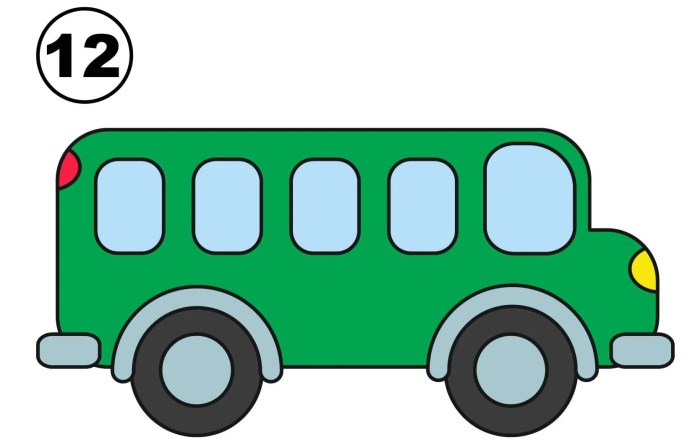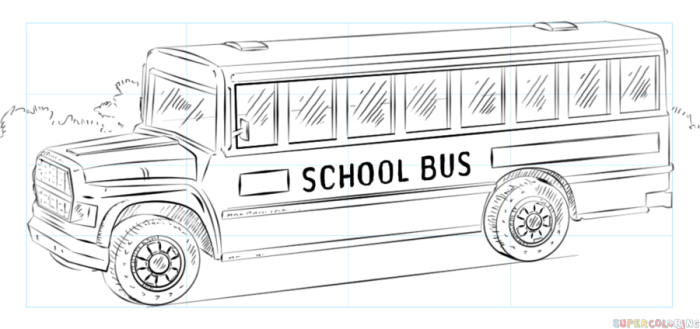Easy Bus Drawing Techniques

Realistic bus drawing easy – Drawing a bus can seem daunting, but by breaking it down into simple shapes and focusing on fundamental drawing principles, even beginners can create a realistic-looking depiction. This section will explore easy techniques to achieve a convincing bus drawing without resorting to complex shading or intricate details. We will focus on utilizing basic geometric shapes, light and shadow manipulation, and line variations to build a believable image.
Creating a realistic bus drawing hinges on understanding the interplay of basic shapes and the effective use of light and shadow to define form. By mastering these techniques, you can produce a surprisingly detailed and convincing drawing with minimal effort.
Basic Bus Shapes
Begin by sketching the overall shape of the bus using simple geometric forms. The body of the bus can be represented as a long rectangle, slightly tapered at the front. The wheels are circles, and the windows can be depicted as rectangles or squares arranged along the side. The roof can be a smaller rectangle placed atop the main body.
By accurately positioning these basic shapes, you establish a strong foundation for your drawing. For instance, consider the perspective; a bus viewed from the side will have a different proportion of rectangular shapes compared to one viewed from a three-quarter angle. The careful arrangement of these initial shapes will significantly improve the accuracy and realism of your final drawing.
Light and Shadow for Realism
Adding light and shadow is crucial for bringing depth and realism to your bus drawing. Instead of complex shading techniques, focus on identifying the main light source. Then, simply darken the areas opposite the light source to indicate shadow. For example, if the light source is from the top, darken the areas underneath the bus and the parts of the bus furthest from the light.
Similarly, adding a slight shadow beneath the wheels will ground the bus and create a sense of three-dimensionality. This simple approach to light and shadow provides a considerable enhancement in realism without needing to master complex shading methods.
Line Variations for Texture and Form
Varying the thickness and darkness of your lines adds texture and form to your drawing. Use thicker lines to emphasize the edges and defining features of the bus, such as the wheels, windows, and headlights. Thinner lines can be used for details such as the seams between panels or the reflections on the windows. This variation in line weight helps to convey the three-dimensional nature of the bus and suggests different materials.
For example, thicker lines can suggest the metallic body, while thinner lines can be used to represent glass windows. This subtle variation can greatly enhance the overall effect of the drawing.
Focusing on Specific Bus Features: Realistic Bus Drawing Easy

Drawing a realistic bus involves paying close attention to detail. Mastering the depiction of key features like wheels, windows, doors, and lights elevates your drawing from a simple sketch to a believable representation. This section will guide you through accurately rendering these elements.
Bus Wheel Depiction
Accurately portraying bus wheels requires understanding their shape and how perspective affects their appearance. Bus wheels are typically circular, but their appearance changes depending on the viewing angle. When drawing a wheel from a direct front or back view, you’ll depict a near-perfect circle. However, from a three-quarter view, the circle will appear elliptical, with the far side of the wheel appearing smaller than the near side.
The degree of ellipticity increases as the viewing angle changes. Consider adding subtle details like tire treads – these can be simplified with short, parallel lines, creating a textured look without excessive detail. Remember to account for the wheel’s position relative to the chassis and the overall perspective of the bus. For instance, wheels further away will appear smaller and potentially more distorted.
Window and Door Representation
Windows and doors are defining features of a bus, significantly impacting its overall appearance. Realistically depicting them requires attention to their size, placement, and the reflection of light on their surfaces. Begin by accurately determining the number and arrangement of windows along the bus’s side. They are usually rectangular or slightly trapezoidal, reflecting the shape of the bus body.
Remember to account for the spacing between windows and their relationship to the bus’s frame. Doors, typically larger than windows, are usually rectangular and often feature a slight curve at the top to match the bus’s roofline. To add realism, consider adding subtle reflections of the surroundings on the glass surfaces of both windows and doors. This can be achieved with light, carefully placed shading to suggest reflections.
Mastering a realistic bus drawing can be easier than you think! Start with basic shapes to build the body and wheels. Once you’ve got the structure down, you can add details like windows and doors. Need a break from vehicles? Try improving your clothing skills by checking out this helpful guide on how to draw a sweater drawing easy , then come back to your bus and add those finishing touches for a truly impressive drawing!
Headlight and Taillight Rendering
Headlights and taillights are crucial for conveying the bus’s functionality and adding a sense of depth to the drawing. Headlights are usually circular or elliptical and positioned at the front of the bus. To portray them realistically, consider adding a bright highlight to suggest the reflection of light. This highlight should be strategically placed to indicate the light source.
The surrounding area should be shaded to create contrast and emphasize the luminosity of the headlights. Taillights, typically located at the rear of the bus, often feature multiple sections or lenses. Similar to headlights, adding a highlight to simulate light reflection enhances realism. Remember to consider the color of the taillights (typically red) and the overall shape, which can vary greatly depending on the bus model.
Subtle shading around the taillights will further enhance their three-dimensional appearance.
Adding Environmental Details

Adding environmental details to your bus drawing elevates it from a simple depiction to a realistic scene. By carefully incorporating background elements, you can create a sense of depth, context, and overall believability, making the bus appear more integrated into its surroundings. This section will explore simple ways to achieve this without detracting from the main focus – the bus itself.Integrating background elements requires a thoughtful approach to ensure they complement the drawing rather than competing with the bus.
The key is to use simple shapes and lines to suggest the environment, avoiding overly detailed backgrounds that might distract the viewer. Consider the overall composition and how the background elements interact with the bus to create a harmonious and believable scene. Perspective plays a crucial role in achieving this sense of realism and scale.
Simple Background Elements
Simple background elements effectively enhance the realism of a bus drawing. These elements should be easy to draw and add depth without overwhelming the main subject. Consider including:
- A road: A simple pair of converging lines suggests a road receding into the distance, providing a clear path for the bus.
- Buildings: Simple rectangular shapes with a few added details like windows or doors can represent buildings. Vary their sizes and placements to create visual interest and depth.
- Trees: Simple vertical lines with a rounded crown at the top effectively represent trees. Varying their height and spacing adds realism.
- Sky: A simple gradient of color, perhaps a lighter shade at the top and a darker shade near the horizon, can create a believable sky.
Integrating Background Elements
Successful integration of background elements hinges on their careful placement and level of detail. Avoid overly intricate details that could overshadow the bus. Instead, focus on suggesting the environment through simplified shapes and lines. For instance, instead of drawing individual bricks on a building, suggest its structure with simple rectangular shapes. Similarly, a few strategically placed lines can indicate the texture of a road surface.
The goal is to create a believable setting without distracting from the main focus.
Using Perspective to Create Scale and Distance, Realistic bus drawing easy
Perspective is a powerful tool for creating depth and scale in your drawing. Using converging lines to depict a road or building creates a sense of distance and makes the bus appear to be located within a three-dimensional space. For example, the road lines converging towards a vanishing point on the horizon makes the road appear to extend into the distance, giving a sense of scale to the bus and the surrounding environment.
Similarly, using smaller buildings and trees in the background creates a sense of distance, while larger objects closer to the bus provide a point of reference for its size. Mastering basic perspective techniques can significantly enhance the realism of your bus drawing.
FAQ Explained
What materials do I need to draw a realistic bus?
Pencil (HB, 2B recommended), eraser, paper, ruler (optional).
How do I improve my bus drawing skills?
Practice regularly, study real buses, and experiment with different techniques. Online tutorials and reference images can also help.
Can I draw a bus from memory?
While challenging initially, with practice, you can learn to draw buses from memory by focusing on their key shapes and proportions.
What if my bus drawing doesn’t look realistic?
Don’t be discouraged! Keep practicing, analyze where your drawing falls short, and use reference images to guide your improvements.
